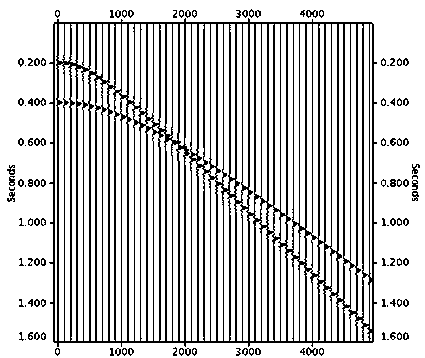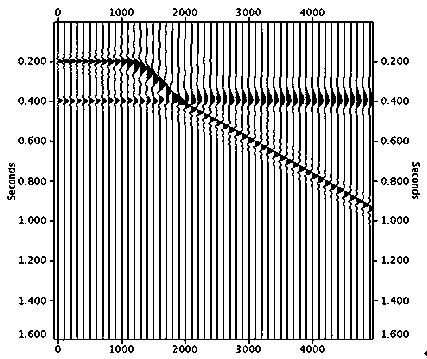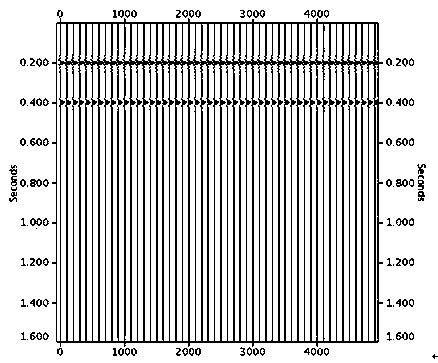Composite wave separation method for moveout correction
A separation method and time difference correction technology, applied in seismology, instruments, measuring devices, etc., can solve the problems of waveform elongation, failure to eliminate waveform distortion, low frequency and other problems, and achieve the effect of meeting the needs of event alignment
- Summary
- Abstract
- Description
- Claims
- Application Information
AI Technical Summary
Problems solved by technology
Method used
Image
Examples
Embodiment 1
[0046] Example 1. A composite wave separation method for time difference correction, comprising the steps of:
[0047] Step 1: Analyze the input seismic data, and select the seismic traces with no aliasing in each waveform as the standard traces.
[0048] Step 2: Compare and analyze the waveform difference between the channel to be separated and the standard channel, divide the time window from the shallow layer to the deep layer, and determine the length of the time window according to the unaliased waveform part in the wave group of the channel to be separated.
[0049] Step 3: Slide the time window and calculate the correlation coefficient between the to-be-separated track and the standard track in a single time window, so that the waveforms of the to-be-separated track and the standard track can basically match.
[0050] Step 4: Calculate the amplitude ratio of the track to be separated and the standard track, and subtract the product of the standard track and the amplitu...
Embodiment 2
[0055] Example 2. A composite wave separation method for time difference correction, the method includes:
[0056] Step 1, select the standard trace, and use the multi-channel data with near-offset waveforms without aliasing to generate the standard trace through conventional dynamic correction and superposition;
[0057] Step 2, select the data time window, compare and analyze the waveform difference between the channel to be separated and the standard channel, and select the time window reasonably according to the non-aliasing part of the wave group to be separated;
[0058] Step 3, sliding the time window so that the cross-correlation coefficient reaches the threshold standard, the waveforms of the track to be separated and the standard track are basically consistent, and the amplitude ratio between the track to be separated and the standard track is calculated;
[0059] Step 4, subtracting the product of the standard track and the amplitude ratio from the track to be sepa...
Embodiment 3
[0063] Example 3. A composite wave separation method for time difference correction. The composite wave separation method includes:
[0064] Step 1, analyze the seismic data, and select the standard trace reasonably;
[0065] Step 2, select the data time window, compare and analyze the waveform difference between the channel to be separated and the standard channel, and select the time window reasonably according to the non-aliasing part of the wave group to be separated;
[0066] Step 3, calculate the cross-correlation coefficient between the track to be separated and the standard track, and slide the time window at the same time, so that the waveforms of the two are basically consistent, and calculate the amplitude ratio between the track to be separated and the standard track;
[0067] Step 4, subtracting the product of the standard track and the amplitude ratio from the track to be separated, thereby stripping the influence of the waveform data in a certain time window; ...
PUM
 Login to View More
Login to View More Abstract
Description
Claims
Application Information
 Login to View More
Login to View More - R&D
- Intellectual Property
- Life Sciences
- Materials
- Tech Scout
- Unparalleled Data Quality
- Higher Quality Content
- 60% Fewer Hallucinations
Browse by: Latest US Patents, China's latest patents, Technical Efficacy Thesaurus, Application Domain, Technology Topic, Popular Technical Reports.
© 2025 PatSnap. All rights reserved.Legal|Privacy policy|Modern Slavery Act Transparency Statement|Sitemap|About US| Contact US: help@patsnap.com



